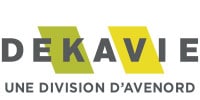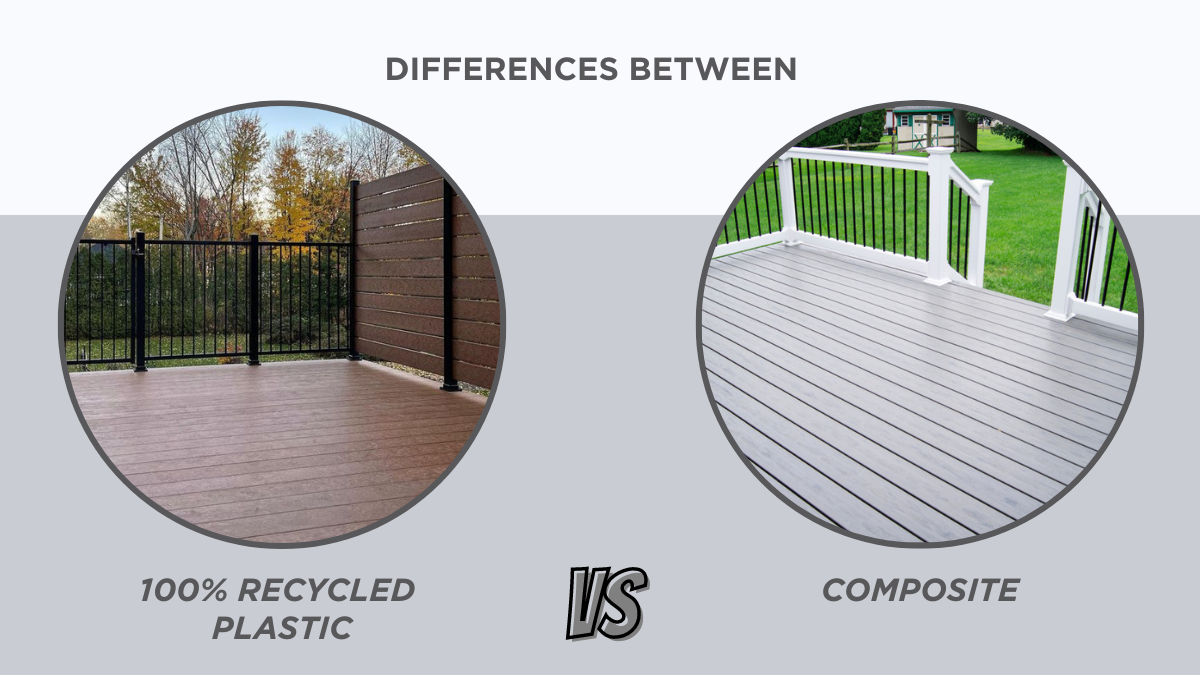Contrary to what many people think, Dekavie recycled plastic decking boards are not composite. So what distinguishes these two products? Read below what are the differences between 100% recycled plastic vs composite.
It is true that at first glance, it can be confusing what is what, since both products look similar. It is quite relevant to ask the question, especially since new patio coverings arrives each spring season!
1. Plastic and Composite Deck Board Composition
In a 100% recycled plastic, it is only High Density Polyethylene. Here are some daily use of HDPE products: laundry detergent container, windshield washer canister, yogurt container. No other plastic is used in the composition.

Polyethylene Benefits:
In opposite, a composite is a mixture of wood residues and plastic (recycled or not). The more a deck board has a high wood composition, the more it will tend to take the properties of the wood (poorer resistance to humidity, risk of developing mold, more sensitive to temperature changes and wear).
If you go to a store, find out an advisor and ask what the composite board are made of.
Note : Only 100% plastic boards can be recycled and transformed into another product. Why? Because they’re not a mix of different materials. Find out more at the ecocentre near you!
2. Resistance to Mold, Moisture and Chemicals
With a 100% recycled plastic board, there is no risk of mold. This material is moisture resistant and does not absorb water. In winter, if you want to apply salt or sand, it will not affect the product.
Unlike a composite board, if there’s an accumulation of water, it is possible that mold will develop because of the wood residues. And inevitably, it will reduce the life of the deck.
3. Deck Boards Installation
To install the 100% recycled plastic tongue and groove deck board, you only need screws and they are not visible once the patio is finished. You can use the same working tools as the wood.
For most wood composite deck boards, you will need mounting clips in addition to screws. And once the patio is finished, the screws may be visible. In addition, most composite boards are not fully colored and some are empty inside. It is then necessary to adapt the design to hide this problem.
Note: Clips increase budget cost as well as installation time.
4. Cleaning the Deck
Although both products are low maintenance, it is still suggested that you wash them well once or twice per season.
For a 100% recycled plastic, a simple wash is enough. If the deck is very dirty, you can loosen the dirt with a soft bristle brush and pressure washer. If necessary, apply a mild soap.
For composite terrace decking, a cleaner consisting of an anti-mold solution is sometimes recommended. Especially for boards that do not have a protective coating.
5. UV Rays and Color
The 100% polyethylene board retains its color. It has no discoloration problem since it’s a recycled decking material that resists UV rays. In addition, a deck board like Dekavie is UV treated and this provides peace of mind: the color is not only on the top but throughout the entire board. If you inadvertently make a deep scratch, it won’t show because the inside of the board is the same color.
Here is a real case lived at Dekavie: “One of our customers wanted to enlarge the first phase of her patio built 14 years ago. After all these years, the color difference between the new boards and her existing patio was very slight, but mostly even.”
As for composite wood, UV rays can alter and sometimes even discolor the color of the board and this situation is irreversible. So find out about the treatments given to the product. It is not uncommon to see this type of product “fading” or “discoloring”.
6. Plastic and Composite Decking Boards Price
Overall, the price per square foot for a full board of Dekavie recycled plastic compared to a full board of composite is less expensive, sometimes even twice the price lower (do not compare with a hollow or semi-hollow core composite board which does not offer a comparable quality at all).
This is also why there is a wide variety of prices in the composite decking boards: the more wood there is, the cheaper it is. And, the more plastic that goes into the composite, the more expensive it is. From $6 to $22 per square foot, the quality and lifespan will be far from the same.
7. The Country of Origin
The Dekavie deck boards are made in Québec for over 26 years now! It facilitates traceability and it is a local product that has proven itself through our climatic conditions. You want to enlarge your deck after several years? No problem, the manufacturer keeps the color codes.
On the other hand, most composite deck boards found in big box stores are made in United States or Asia. It will be more difficult to find a color years later and if a problem arises, it can be more difficult to fix it.
In conclusion, a Dekavie deck board made from 100% recycled plastic versus a composite patio is an option that will allow you to build your dream terrace. It’s up to you to make the right choice for a sustainable terrace!
 English
English

